|
WAR IN THE PACIFIC National Historical Park |
U.S. Department of the Interior National Park Service |

|

| The Pacific Theater, 1941-45 |
|
The Pacific Theater of World War II involved one-third of the earth's surface but only 1/145th of its total land mass. It involved vast distances and new strategy, tactics, equipment, and weapons of war. Moreover, it involved not just Japan and the United States but Great Britain, Australia, New Zealand, the Netherlands, Canada, China, France, and the Soviet Union as well. Caught in the middle were the people of the Pacific islands, upon whose homelands and in whose waters the battles were fought. The following chronology touches on some of the more significant aspects of the Pacific War and provides a framework for understanding the people and events commemorated at War in the Pacific National Historical Park. |
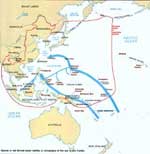 (click on image for an enlargement in a new window) |
1941
| 7 December | Without warning, Japanese planes bomb Pearl Harbor and Hickam and Wheeler Airfields on Oahu, and within 30 minutes destroy the power of the U. S. Pacific battle fleet—except for aircraft carriers Enterprise, Lexington, and Saratoga, which are at sea; Japan declares war on the United States and Great Britain. The Pacific war that the United States suddenly found herself embroiled in had begun many years before the attack on Pearl Harbor when Japan, lacking the raw materials for modern industrialization, looked to mineral-rich Manchuria to supply them. Japanese attacks on China led to open warfare in July 1937. As a result of Japan's involvement in China and the extension of Japan's "Greater East Asia Co-Prosperity Sphere" into Indochina, the United States, Great Britain, and other countries froze Japanese assets and exports, threatening Japan's industrial survival. This led to accelerated Japanese economic expansion into Southeast Asia and the Dutch East Indies, bringing her into direct conflict with western countries which also had economic interests in these areas. By 1941, Japan was committed to a policy of aggression to achieve her goals. Her inability to come to diplomatic terms with the United States, which she saw as her most formidable opponent, led to the Pearl Harbor attack. |
| 8 December | Congress declares war on Japan; Japanese bomb islands of Wake and Guam, and Clark's and Iba Airfields in the Philippines; invade Malaya and occupy Thailand; and seize the international settlement of Shanghai. |
| 10 December | Japanese capture Guam and begin landings on northern Luzon. |
| 23 December | Wake Island is surrendered to the Japanese. |
| 24 December | Gen. Douglas MacArthur, commanding United States Army Forces in the Far East, begins evacuation of Manila and withdraws to Bataan. |
| 26 December | Hong Kong is lost to the Japanese. |
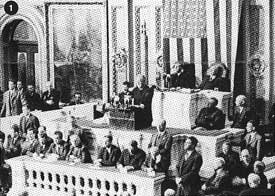 |
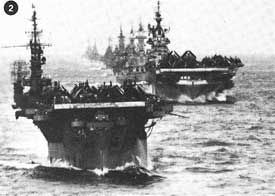 |
| President Franklin D. Roosevelt asks Congress to declare war on Japan, December 8, 1941. | US Navy task group returns to anchorage for repairs and supplies after strikes against the Japanese in the Philippines, December 1944. |
1942
| 2 January | Japanese occupy Manila. |
| 7 January | Siege of Bataan begins. MacArthur, headquartered on Corregidor, proclaims the Bataan Peninsula the center of American-Filipino resistance to the Japanese invasion of the Philippines. But the jungles, swamps, and mountains make supply difficult and the Bataan Defense Force suffers shortages of food and medicines throughout the three-month ordeal. |
| 1 February | U.S. Navy launches air and surface attacks against Japanese bases in the Marshall Islands. |
| 15 February | Singapore surrenders. |
| 27-28 February | Battle of Java Sea results in most severe U.S. naval losses since Pearl Harbor and leads to the collapse of organized Allied military resistance in that area. |
| 8 March | Japanese land in New Guinea, occupying Lee and Salamaua, and threatening Port Moresby, last defensive post held by the Allies to protect Australia. |
| 17 March | MacArthur, who had left the Philippines size days before, arrives in Australia. Here he utters the now-famous words, "I came through and I shall return." |
| 30 March | MacArthur is designated Allied Supreme Commander, Southwest Pacific Areas (Australia, most of the Indies, and the Philippines); Adm. Chester Nimitz is designated Commander in Chief, Pacific Ocean Area. |
| 9 April | Bataan surrenders. The starving U.S. and Filipino survivors begin a 60-mile "death march" to Japanese prison camps. |
| 18 April | Lt. Col. James H. Doolittle leads sixteen B-25 bombers from carrier Hornet to bomb targets in Tokyo, Yokohama, Yokosuka, Kobe, and Nagoya. |
| 7 May | Gen. Jonathan Wainwright, MacArthur's successor in the Philippines, surrenders Corregidor and all U.S. troops under his command. |
| 4-8 May | Battle of the Coral Sea. This Japanese tactical victory but strategic defeat is the first naval battle in history in which all fighting is done by carrier-based planes and the opposing ships never saw each other. |
| 3-6 June | Battle of Midway. This American victory deals the Japanese their first major naval defeat, and confirms the power of the aircraft carrier as an offensive weapon in war. |
| 7 June | Japanese occupy Attu and Kiska in the Aleutian Islands. |
| 22 July | Papuan Campaign begins as Japanese troops land at Gona and Buna, 100 miles east of Lae and Salamaua in northern New Guinea, and begins an overland drive across the Owen Stanley Mountains to capture Port Moresby on the southern coast. In the months that follow, Australian and U.S. forces frustrate every attempt to take the port and eventually drive the Japanese back to Gona and Buna. |
| 7 August | U.S. Marines invade Guadalcanal in the Solomon Islands in the first American offensive of the war. Subsequent Japanese efforts to drive the Americans off the island are consistently unsuccessful. |
| 8-9 August | Japanese navy sinks four Allied cruisers in Battle of Savo Islands. |
| 24 August | Battle of Eastern Solomons results in sinking of one Japanese carrier by aircraft from USS Enterprise and USS Saratoga. |
| 12-15 November | The decisive American victory in the naval Battle of Guadalcanal prevents the Japanese from landing reinforcements and makes possible the final conquest of Guadalcanal by U.S. forces. |
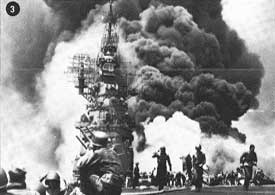 |
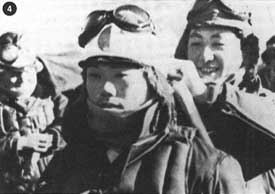 |
| Crew of carrier USS Bunker Hill battle fires resulting from kamikaze attack during Okinawa campaign, 1945. | Japanese kamikaze pilots prepare for a mission, 1944. |
1943
| 10 January | U.S. troops begin final offensive to clear Guadalcanal. By February 9 organized Japanese resistance on the island is ended. The American victory opens the way for other Allied gains in the Solomons. |
| 22 January | Papuan Campaign ends in the first decisive land defeat of the Japanese. |
| 2-3 March | Battle of the Bismarck Sea. U.S. and Australian aircraft decimate a 16-ship Japanese supply convoy bound for Lae and Salamaua, New Guinea, demonstrating the effectiveness of low-level bombing. |
| 26 March | An indecisive naval battle off the Komandorski Islands prepares the way for reconquest of the Western Aleutians. By mid-August Japanese troops have been driven out of both Attu and Kiska. |
| 5 August | Munda Airfield, New Georgia, is captured, providing Allied forces a base from which to bomb Japanese air and naval facilities at Rabaul. |
| 25 August | Americans overrun New Georgia, Solomon Islands, thus removing the Japanese threat to forces on Guadalcanal. |
| 20 November | Admiral Nimitz' Central Pacific offensive to reconquer the Marshall, Gilbert, Caroline, Mariana, and Philippine Islands begins with army landings on Makin and Marine landings on Tarawa, the keystones of Japanese defenses in the Gilberts. |
| 26 December | General MacArthur's Southwest Pacific offensive to secure the western Solomons, New Guinea, and the Philippines begins with the landings on New Britain, the largest island in the Bismarck Archipelago. |
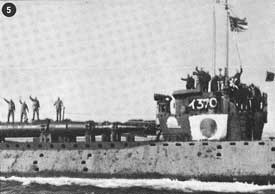 |
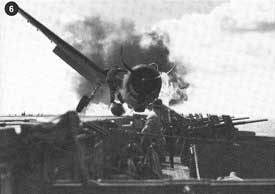 |
| Japanese submarine I-370 carrying Kaiten one-man torpedoes enroute to attack US fleet of Iwo Jima, 1945. | Navy officer scrambles to assist Hellcat pilot who has crash landed on the deck of carrier USS Enterprise, 1944. |
1944
| 31 January-4 February | American forces capture Roi-Namur and Kwajalein in the Marshalls. |
| 29 February-7 March | MacArthur surprises Japanese by seizing the Admiralty Islands. |
| 15 June | China-based B-29s make their first attack on Japanese homeland. U.S. forces invade Saipan. |
| 17-19 June | Battle of the Philippine Sea (called the Marianas "turkey shoot"), in which U.S. carrier-based aircraft engage and inflict crippling losses on Japanese carrier-based aircraft. |
| 21 July | U.S. forces invade Guam. |
| 24 July | U.S. forces invade Tinian. |
| 15 September | U.S. forces invade Morotai and Peleliu. |
| 20 October | U.S. forces invade Leyte. |
| 23-25 October | Battle of Leyte Gulf, the last and greatest naval engagement of the war, results in near destruction of the Japanese Navy. |
| 24 November | Air offensive against Japan begins with B-29 attacks on Tokyo from bases in the Marianas. |
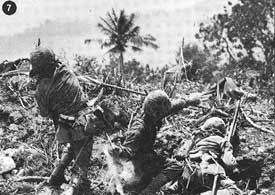 |
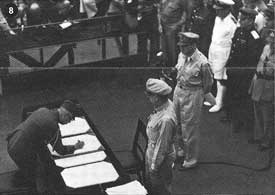 |
| US Marines hurl grenades at Japanese positions during the fighting on Saipan, 1944. | Japanese Gen. Yoshijiro Umezu signs document of surrender aboard USS Missouri, September 2, 1945. |
1945
| 9 January-23 February | Reconquest of northern Philippines begins as U.S. forces invade Luzon and occupy Manila. |
| 19 February-17 March | U.S. Marines invade and conquer island of Iwo Jima after bitter fighting. |
| 9-10 March | B-29 fire-bomb attack on Tokyo leaves much of the city in ashes and inaugurates a series of incendiary strikes against other Japanese cities. |
| 19 March-21 June | Battle for the Ryukyu Islands, in which U.S. carrier-based planes make large-scale attacks on Japanese ships and airfields in the Ryukyus. |
| 1 April-21 June | U.S. troops invade and capture Okinawa, main island of the Ryukyus, Japanese military forces inflict heavy casualties on American troops, but the island is finally secured. |
| 6 August | Air Force drops atomic bombs on Hiroshima. A second atomic bomb is dropped on Nagasaki three days later. |
| 14 August | Japan accepts Allied unconditional surrender terms. |
| 2 September | Japan signs formal terms of surrender. |
Last Updated: 09-Mar-2004